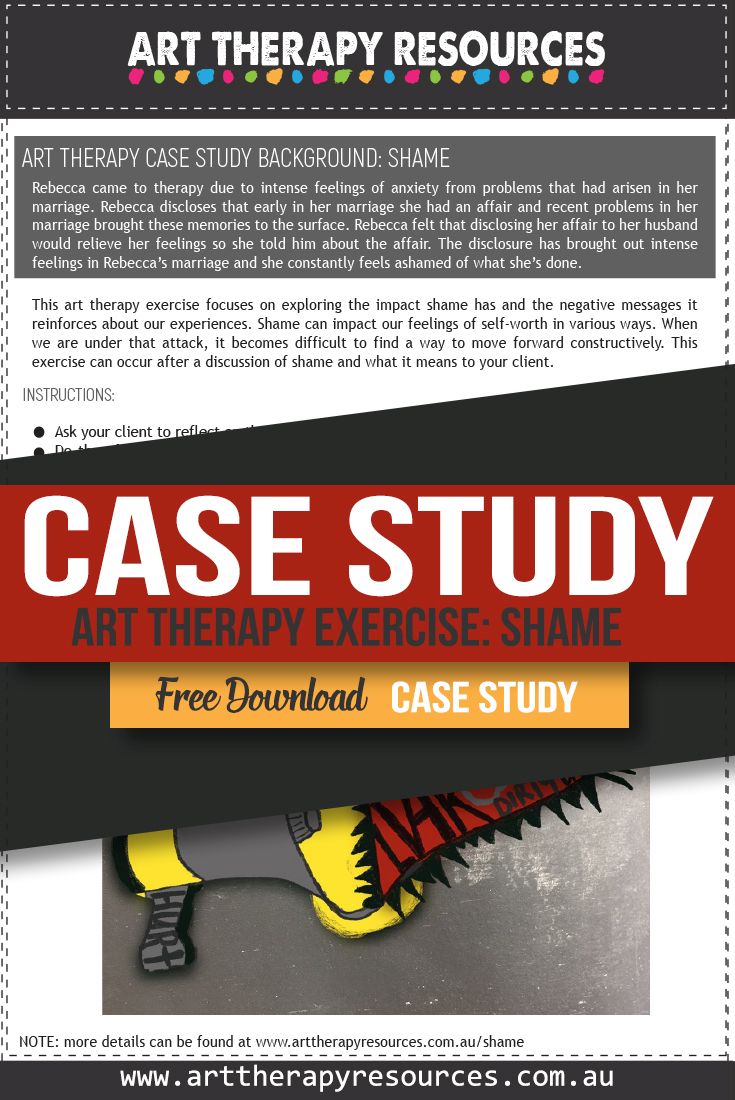THIS POST INCLUDES:
- Art Therapy and Shame
- About the Client
- Art Therapy Exercise
- Client Insight and Outcomes
- Disclaimer
- FREE DOWNLOAD Art Therapy Exercise
ART THERAPY AND SHAME
Most clients who come to therapy will be experiencing some form of shame as part of their mental health difficulties. To compound the feelings of shame connected with the experiences that bought them to therapy, clients will often also feel a sense of shame because of the associated stigma that is attached to seeking help for mental health issues.
Shame can often be represented through physical expressions such as avoiding eye contact, fumbling over words, and submissive posturing to hide oneself. These expressions can also be connected with other experiences such as anxiety, so the therapist should use an inquisitive approach before assuming a client is either experiencing shame, anxiety, or another emotion.
While shame has a strong link to the above gestures in most people, some clients use more overt behaviours to mask their shame. This can include loudness, anger, and contempt.
All behaviour for shame is classified as an internal defense to protect the innerself.
Shame can often be confused with the emotion of guilt. One way to differentiate these two experiences is to understand that guilt identifies that the person has done a bad thing, however, shame attempts to reinforce that we are bad at our very core. From this perspective dealing with guilt can be more accessible as it helps to separate the person’s value from the mistake they may have made. On the other hand, shame embraces the mistake as if it is evidence that the core nature of the person is bad.
There is an argument that suggests guilt has an important purpose in social functioning where a person can feel motivated by guilt to make amends and adjust their moral behaviour. On the other hand, shame has no connecting benefit as it intends to keep all aspects of the individual’s experience hidden and therefore the individual embedded in the experience of suffering.
Both shame and guilt are linked strongly with judgment specifically about ourselves and also experiencing judgment from others. To combat our feelings of judgment connected with shame and guilt, we need to develop the ability to extend compassion to ourselves.
Shame is associated with experiences that define the individual as either the transgressor or the victim. Many clients may come to your therapy office under the premise of wearing either of those labels. An example is when a person has been directed to undertake therapy as part of a rehabilitation program connected to a crime. However, a psychotherapeutic approach understands that shame is not an emotion that can be defined into black and white labels. Instead many people who experience trauma often internalise their feelings of shame and externalise them through destructive behaviours.
It’s important to remember that shame is a wide reaching emotion that is connected to a vast range of experiences that may appear in conflict with each other. From this point of view, therapists should keep an open mind as to the source of a client’s shame as they explore various experiences in their life through art therapy.
Some experiences that result in high levels of shame include:
- Infidelity
- Sexual abuse
- Childhood abuse
- Not meeting family expectations of success
- Socially inappropriate behaviour
- Breaching expected cultural and religious norms
In some of the situations above a feeling of shame can result from the individual self-assessing their behaviour. Additionally, some situations are based on social groups targeting individuals to feel shame for their behaviour.
HOW ART THERAPY CAN HELP WITH SHAME
Given the complexity of shame and its many origins, dealing with shame can involve many stages that require specific attention. Initially, the difficulty may involve the client acknowledging that they are experiencing shame. To acknowledge shame can feel humiliating to some clients as they feel it identifies the specific parts of them that are worthy of rejection by others including their therapist.
Secondly, it is useful to introduce techniques to develop self-compassion for the client. As a therapist, offering empathy and compassion is paramount to helping the client explore their feelings of shame. Empathy and compassion are the antidotes to the internal feelings that shame attempts to foster within us.
Thirdly, we mentioned previously that guilt can be viewed as a more tenable emotion than shame. It differentiates problem behaviours that may be out of the ordinary and keeps them separated from the core value of the person. This is especially important in circumstances where the client is experiencing shame as a result of sexual abuse where the experience has no connection to their behaviour or value.
Given the unconscious aspects of shame, this is an area where art therapy is especially valuable. Clients who find difficulty in verbalising their inner thoughts and emotions can use art therapy techniques to explore what cannot be said.
Additionally, for many people, memories of past events are often represented in our mind by visual images, not words. We may recall conversations held in the past, however, those conversations are usually recalled with visual imagery.
A significant benefit of art therapy is it poses as a non-threatening method in which the client and therapist can build a therapeutic alliance. Shared goals often bring people together, and with art therapy, a shared art exercise can help forge this alliance. This is also the case in group work where many individuals collaborate on an art exercise.
Another strength of art therapy is it facilitates the client’s ability to express themselves through the use of metaphors. A client may create butterflies to signify change and growth or use the image of fire to signify anger. The use of metaphors can be useful for clients who have difficulty expressing and labeling emotions or want to avoid putting damaging words to difficult experiences.
ABOUT THE CLIENT
- Name: Rebecca
- Age: 36
CURRENT CLIENT ISSUES:
Rebecca came to therapy due to intense feelings of anxiety from problems that had arisen in her marriage. Rebecca discloses that early in her marriage she had an affair and recent problems in her marriage brought these memories to the surface.
Rebecca felt that disclosing her affair to her husband would relieve her feelings so she told him about the affair. The disclosure has brought out intense feelings in Rebecca’s marriage and she constantly feels ashamed of what she’s done.
ART THERAPY EXERCISE
When we are under that attack, it becomes difficult to find a way to move forward constructively.
This exercise can occur after a discussion of shame and what it means to your client.
INSTRUCTIONS:
- Ask your client to reflect on their experience of feeling shame.
- Do they feel there are common negative messages about their self-worth that is arising from feelings of shame?
- What is shame trying to tell your client about themselves? Maybe it is attacking through name-calling or staying in a loop of replaying hurtful conversations or images.
- Ask your client to reflect these feelings through artwork.
- Explore with your client the concept of using the artwork as a container to hold those feelings. This container is a safe space to express all hidden thoughts and emotions they may feel.
CLIENT INSIGHT AND OUTCOMES
Rebecca saw the megaphone was separate from herself and was a tool used to create an impact on her and not an internal or innate part of her.

DISCLAIMER
FREE DOWNLOAD: Art Therapy Exercise

BUILD YOUR ART THERAPY REFERENCE MATERIALS:
Pin this image to your Pinterest board.

SHARE KNOWLEDGE & PASS IT ON:
If you’ve enjoyed this post, please share it on Facebook, Twitter, Pinterest. Thank you!
